On this page
-
The Immigration and Refugee Board of Canada (IRB) - overview
-
IRB Regions and Office Locations
-
Organizational Structure and Biographies
-
Financial and Human Resources
-
Appointment and Reappointment of GIC Members
-
Tribunal Independence
-
Engagement with Partners and Stakeholders
-
Operating Context & Strategic Objectives
-
2019-2020 Operational Plans – Results to Date
-
IAD Operational Plan Overview
-
ID Operational Plan Overview
-
RAD Operational Plan Overview
-
RPD Operational Plan Overview
-
Inventory Overview – Divisional Statistics
-
RPD Inventory Analysis
-
RAD Inventory Analysis
-
ID / IAD Inventory Analysis
-
Top Media Stories and Active Litigation
-
Key Issues Requiring Ministerial Support
The IRB - An Overview
Created by an Act of Parliament in 1989, the Immigration and Refugee Board of Canada (IRB) is Canada’s largest administrative tribunal. Like every administrative tribunal, the IRB must exercise its decision-making authority independently, in a manner that is fair, transparent and efficient, and in accordance with the rules of natural justice. The primary statutory framework governing the IRB and defining the basic features of its organizational structure is the
Immigration and Refugee Protection Act (IRPA), which became law in 2002 and was substantively reformed in 2012.
The IRB’s mission, on behalf of Canadians, is to
resolve immigration and refugee cases efficiently, fairly and in accordance with the law. The IRB reports to Parliament through the Minister of Immigration, Refugees and Citizenship and contributes directly to Canada’s humanitarian traditions, the security of Canada and the quality of life of Canadians, as well as to the fulfillment of our international obligations. It consists of four divisions:
-
Refugee Protection Division (RPD) makes determinations of whether a claimant meets the definition of a refugee under the 1951 UN Refugee Convention (i.e. due to a fear of persecution by reason of race, religion, nationality, membership in a particular social group or political opinion) or a person in need of protection (i.e. because they face torture, a risk to life or risk of cruel and unusual treatment or punishment) under the IRPA. The RPD also hears applications for cessation or vacation of refugee protection. A person may “cease” to hold their refugee status if they are found to have re-availed themselves of the protection of their country of nationality or have obtained protection from another country. A person can have their refugee status vacated if they obtained their status by means of misrepresentation or withholding material facts. In either of these situations, the Minister can make an application which, if allowed by the RPD, will result in the protected person losing his or her refugee protection.
-
Refugee Appeal Division (RAD) considers appeals against decisions of the RPD to allow or reject claims for refugee protection. In most cases, there will be no hearing as the RAD will base its decision on the documents provided by the parties involved and the RPD record. The RAD decides whether to confirm or to change the RPD’s decision. It may also decide to send the case back to the RPD to hear it again, giving the directions to the RPD that it considers appropriate. In addition, the RAD has an important role in clarifying matters of refugee law and shaping refugee decision-making at both the RPD and RAD by advancing its adjudicative role and the strategic development of coherent and consistent jurisprudence.
-
Immigration Division (ID) conducts hearings on immigration-related matters. These include:
-
Admissibility hearings: Where the Canada Border Services Agency (CBSA) believes that a permanent resident or foreign national is inadmissible to or removable from Canada, the matter may be referred to the ID for an admissibility hearing. Grounds for inadmissibility include security; human rights or international violations; criminality; and misrepresentation. Where a finding of inadmissibility is made, the ID will issue a removal order against the person concerned.
-
Detention reviews: The Division conducts detention reviews of foreign nationals or permanent residents detained by the CBSA under the IRPA. The CBSA has the authority to detain foreign nationals and permanent residents for a number of reasons, including in situations where the Agency believes the individual is inadmissible to Canada; is a danger to the public; is unlikely to appear for immigration processes; or in cases where a foreign national is unable to establish their identity. Detention review hearings are required by law to be held at regular intervals beginning at 48 hours of detention, with subsequent reviews being held after 7 days and then after every 30 days for as long as the person remains detained. The law requires the ID to order the release of a detainee unless one of the prescribed grounds for detention is met. Grounds for detention include danger to the public; unlikely to appear for an examination, a hearing or removal; inadmissibility for security reasons; serious criminality, criminality, organized criminality or violating human or international rights; or non-establishment of identity. At a detention review, the onus is always on the Minister’s counsel to demonstrate that there are reasons which warrant detention in all circumstances of the case.
-
Immigration Appeal Division (IAD) hears appeals on immigration-related matters. These include:
-
Sponsorship appeals: If Immigration, Refugees and Citizenship Canada (IRCC) has refused the application of a Canadian citizen or a permanent resident to sponsor the immigration of a close family member to Canada, the sponsor may appeal to the IAD. Sponsorship appeals represent the majority of the Division’s workload.
-
Removal order appeals: Where a removal order has been issued against a permanent resident of Canada or refugee, for example for having committed a serious crime or for having committed misrepresentation, the person concerned may, with certain exceptions, file an appeal to be allowed to stay in Canada and maintain their permanent residence status.
-
Ministerial appeals: The Minister may file an appeal to the IAD to challenge an Immigration Division decision at an admissibility hearing in r of the person concerned.
-
Residency obligation appeals: The law requires permanent residents to be physically present in Canada for at least 730 days out of every five years. If a permanent resident is outside Canada and a visa officer with IRCC finds that he or she has not met this residency obligation, the person may lose permanent resident status. The permanent resident may appeal the decision.
In addition to its four Divisions, the IRB also has staff under its Executive Director who deliver a range of strategic and operational services to the Board’s senior leadership and decision-makers. These support functions include:
-
Adjudicative Support which consists primarily of professional support to decision-making (e.g., registry, scheduling of cases, triage, research, tribunal officers and case management). It also consists of professional advice and support in relation to the development of the Board’s adjudicative and operational policies.
-
Corporate Support which consists of functions required to support the management of the Board through corporate and administrative activities encompassing corporate services (i.e. planning, finance, information technology and administration), human resources and communications.
Geographically, IRB operations are managed across three regions: Western, Central and Eastern. The IRB has offices in five cities: Vancouver, Calgary, Toronto, Ottawa and Montreal, with itinerant sites in Edmonton and Winnipeg where hearings are conducted remotely by video-conferencing or in-person by members on an as required basis. The IRB’s National Headquarters are in Ottawa.
Please refer to the attached Tab A showing IRB office locations as well as the funded employee complement in each office.
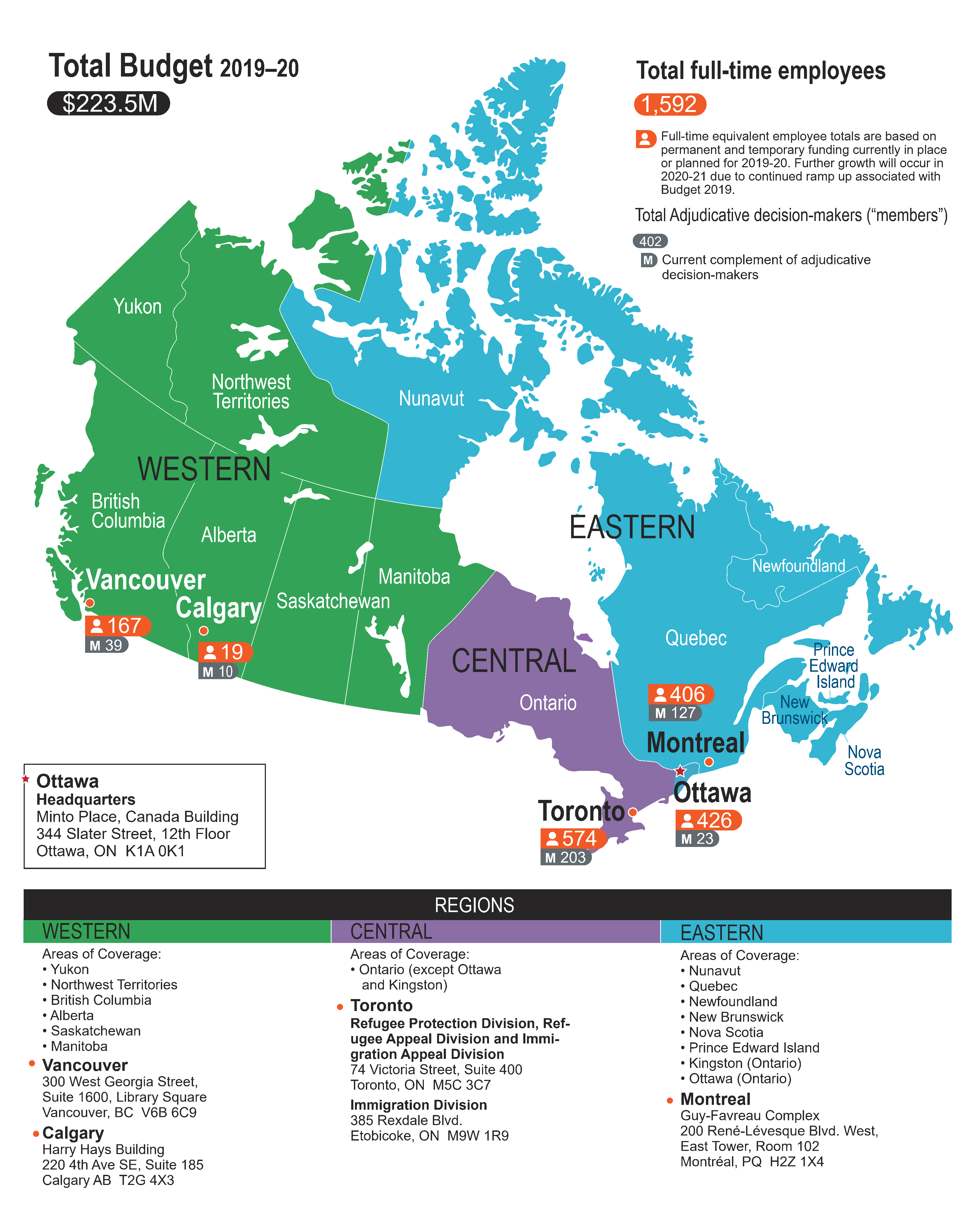
Text format
Transition Binder – Canada map
Total Budget 2019–20
$223.5M
Total full-time employees
1,592
Full-time equivalent employee totals are based on permanent and temporary funding currently in place or planned for 2019-20. Further growth will occur in 2020-21 due to continued ramp up associated with Budget 2019.
Total Adjudicative decision-makers (“members”)
Current complement of adjudicative decision-makers
402
Ottawa
Headquarters
Minto Place, Canada Building
344 Slater Street,
12th Floor Ottawa, ON
K1A 0K1
Regions
|
|---|
| Western |
|---|
-
Areas of coverage:
- Yukon
- Northwest Territories
- British Columbia
- Alberta
- Saskatchewan
- Manitoba
| -
Vancouver
300 West Georgia Street,
Suite 1600, Library Square
Vancouver, BC V6B 6C9
| -
Calgary
Harry Hays Building
220 4th Ave SE, Suite 185
Calgary AB T2G 4X3
|
| | Central |
|---|
-
Areas of coverage:
- Ontario (except Ottawa and Kingston)
| -
Toronto
Refugee Protection Division, Refugee Appeal Division and Immigration Appeal Division
74 Victoria Street, Suite 400
Toronto, ON M5C 3C7
Immigration Division
385 Rexdale Blvd.
Etobicoke, ON M9W 1R9
|
| | Eastern |
|---|
-
Areas of coverage:
- Nunavut
- Quebec
- Newfoundland
- New Brunswick
- Nova Scotia
- Prince Edward Island
- Kingston (Ontario)
- Ottawa (Ontario)
| -
Montreal
Guy-Favreau Complex
200 René-Lévesque Blvd. West,
East Tower, Room 102
Montréal, PQ H2Z 1X4
|
|
Senior Leader Biographies

Richard Wex – Chairperson
Mr. Wex was appointed Chairperson and Chief Executive Officer of the Immigration and Refugee Board of Canada in July, 2018.
From 2015-2018, Mr. Wex was the Associate Deputy Minister of Immigration, Refugees and Citizenship Canada. Prior to this appointment, he served as Vice-President of the Canada Border Services Agency (CBSA) responsible for policy and program development. From 2007 to 2013, Mr. Wex served as Assistant Deputy Minister of the Law Enforcement and Policing Branch at Public Safety Canada, where he provided strategic leadership and policy advice to the Minister of Public Safety. Prior to joining Public Safety Canada, Mr. Wex held a number of executive positions with the Department of Fisheries and Oceans and the Department of Justice. He began his public service career with the Department of Justice, practicing in the areas of Public and Aboriginal law, and providing the full range of advisory, negotiation and litigation services.
Mr. Wex has a Bachelor of Laws degree (L.L.B.) from Queen's University, and is a member of the Law Society of Ontario. He is a graduate of the Public Service Advanced Leadership Program, and the Senior Managers in Government Program from the John F. Kennedy School of Government at Harvard University. He is a recipient of both the Public Service Award of Excellence as well as the Queen’s Diamond Jubilee Medal in recognition of his contributions to Canada.

Jason Choueiri - Executive Director and Chief Financial Officer (CFO)
Jason Choueiri was appointed Executive Director of the IRB in September 2018. Previously, Mr. Choueiri served as Director General for Transformation Planning, Design and Oversight at Employment and Social Development Canada (ESDC), where he founded ESDC’s Acceleration Hub and led the development and implementation of multi-year service improvement strategies and service design practices. Prior to this, he served as the Director General, Strategic Directions where he developed the long-term vision for the modernization of Canada’s three largest statutory programs (Employment Insurance, Canada Pension Plan, and Old Age Security). Mr. Choueiri has also held several senior roles at Shared Services Canada, National Defense and Innovation, Science and Economic Development Canada.
Mr. Choueiri has a Master’s degree in Business Administration, as well as Bachelor of Commerce, Specialization in Management of Information Systems from the University of Ottawa. He is a recipient of the Queen’s Diamond Jubilee Medal in recognition of his contributions to Canada.

Roula Eatrides - Deputy Chairperson of the Refugee Protection Division
Roula Eatrides was appointed Deputy Chairperson of the Refugee Protection Division (RPD) in September 2019. Ms. Eatrides joined the IRB in 2018 as Deputy Chairperson of the Immigration Division (ID). Previously, she was the Deputy Superintendent for Operations and Corporate Services at the Office of the Superintendent of Bankruptcy. Ms. Eatrides has also served as Executive Director and General Counsel at the Federal Court and as Registrar of the Tax Court of Canada, for which she managed all registry services. Prior to joining the Public Service, Ms. Eatrides practiced law at Osler and Stikeman Elliott and taught Corporate Finance for several years as a part-time professor at the University of Ottawa's Common Law Program.
Eatrides is a member of the Ontario Bar and holds an undergraduate degree in Economics, a Bachelor of Laws Degree and a Master’s Degree in Business Administration. She has been recognized for her contributions, including a Public Service Award of Excellence in 2015 for Management Excellence and a Diamond Jubilee Medal in 2012.
Suzanne Gilbert - Deputy Chairperson of the Immigration Appeal Division
Suzanne Gilbert was appointed Deputy Chairperson of the Immigration Appeal Division (IAD) at the Immigration and Refugee Board of Canada (IRB) in April 2019. Prior to this appointment she held the position of Assistant Deputy Chair (ADC) of the IAD Central Region. From 2006 to 2016, Ms. Gilbert held a number of positions, including Chair and Associate Chair for the Social Justice Tribunals Ontario with the Child and Family Services Review Board and Custody Review Board. Prior to that appointment, she worked in a number of positions at the IRB in Montreal and Toronto, including Assistant Deputy Chairperson of the Refugee Protection Division in Toronto.
Ms. Gilbert holds a Master's Degree in Health Law from the Université de Sherbrooke and was called to the Barreau du Québec in 1981.
Paula Thompson - Deputy Chairperson of the Refugee Appeal Division
Paula Thompson was appointed as the Deputy Chairperson of the Refugee Appeal Division (RAD) in April 2019. Ms. Thompson has also served as Assistant Deputy Chairperson at the RAD. Previously, as IRB Chief of Staff, she provided strategic leadership and policy advice to a number of former IRB Chairpersons. Ms. Thompson has extensive experience in refugee law and adjudication and has held a number of executive positions within the IRB. Paula has also worked with the Organisation for Security and Cooperation in Europe (OSCE) in Bosnia-Hercegovina, Romania and Ukraine.
Ms. Thompson has a Master of Laws degree in International Human Rights Law from the University of Essex in the United Kingdom. An expert in minority rights in the former Soviet Union and Eastern Europe, Paula has also studied at the University of Vienna and Carleton University. She is a recipient of the Public Service Award of Excellence.
Greg Kipling - Deputy Chairperson for the Immigration Division
Greg Kipling was appointed Deputy Chairperson of the Immigration Division (ID) in October 2019. Prior to this appointment he was Director General for Policy, Planning Corporate Affairs at the IRB. Between 1999 and 2016 Mr. Kipling served in a number of progressively senior positions at the Board, including Director of Research, Chief of Staff to the Chairperson and Director General for Policy, Planning and Research. Prior to joining the IRB, Mr. Kipling worked as a consultant in the field of Indigenous health and human rights as well as a researcher and writer on social issues.
Mr. Kipling holds Bachelor of Arts degrees from the University of Toronto and Carleton University as well as a Master of Arts degree from Carleton University.
Holly Holtman – Senior General Counsel
Holly Holtman is currently Senior General Counsel at the Immigration and Refugee Board of Canada. Holly has worked as a legal advisor for the Government of Canada in a variety of capacities such as General Counsel at the Office of the Integrity Commissioner mandated to administer a whistleblowing regime, and with the Canadian Department of Justice as Senior Counsel at Indian Residential Schools Resolution, Fisheries and Oceans, the Privy Council Office and the Aboriginal Affairs Portfolio. Ms. Holtman holds an Honours Bachelor of Arts from Harvard University and an LL.B. from Queen’s University.
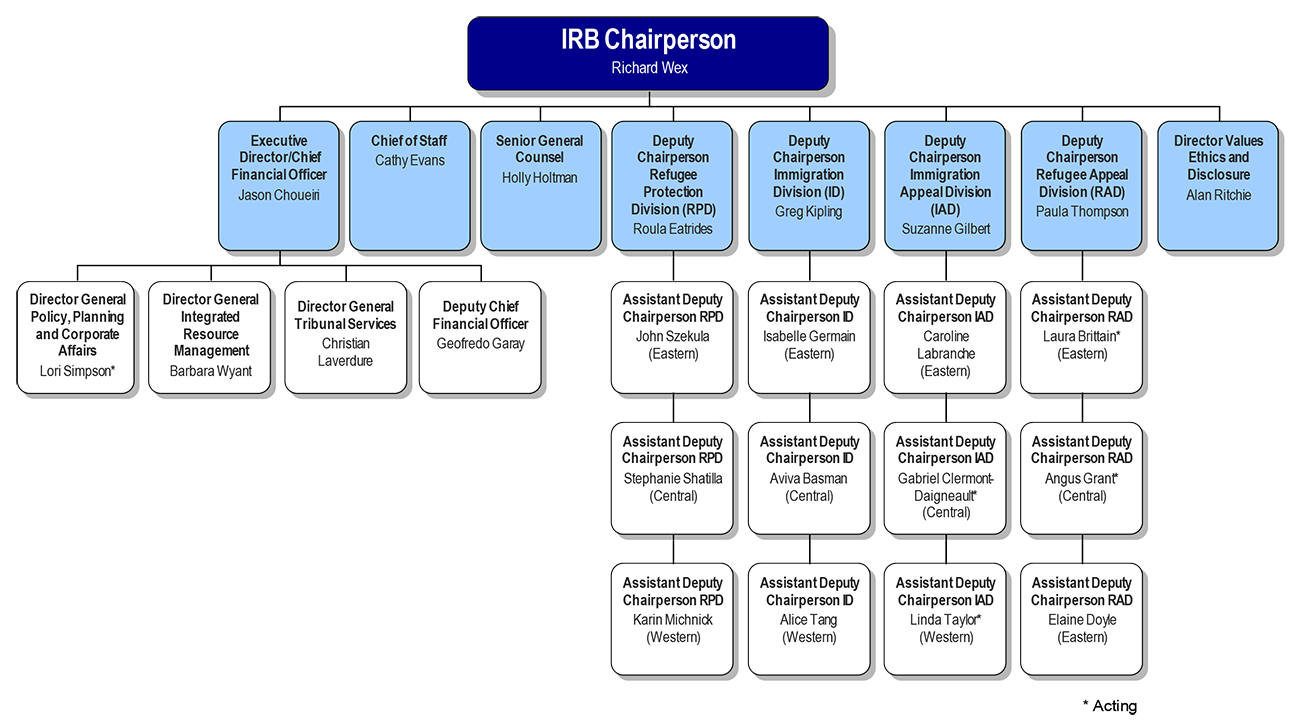
Text format
- IRB Chairperson - Richard Wex
- Executive Director/Chief Financial Officer - Jason Choueiri
- Director General Policy, Planning and Corporate Affairs - Lori SimpsonFootnote 1
- Director General Integrated Resource Management - Barbara Wyant
- Director General Tribunal Services - Christian Lavendure
- Deputy Chief Financial Officer - Geofredo Garay
- Cheif of Staff - Cathy Evans
- Senior General Counsel - Holly Holtman
- Deputy Chairperson Refugee Protection Division (RPD) - Roula Eatrides
- Assistant Deputy Chairperson RPD (Eastern) - John Szekula
- Assistant Deputy Chairperson RPD (Central) - Stephanie Shatilla
- Assistant Deputy Chairperson RPD (Western) - Karin Michnick
- Deputy Chairperson Immigration Division (ID) - Greg Kipling
- Assistant Deputy Chairperson ID (Eastern) - Isabelle Germain
- Assistant Deputy Chairperson ID (Central) - Aviva Basman
- Assistant Deputy Chairperson ID (Western) - Alice Tang
- Deputy Chairperson Immigration Appeal Division (IAD) - Suzanne Gilbert
- Assistant Deputy Chairperson IAD (Eastern) - Caroline Labranche
- Assistant Deputy Chairperson IAD (Central) - Gabriel Clemont-DaigneaultFootnote 1
- Assistant Deputy Chairperson IAD (Western) - Linda TaylorFootnote 1
- Deputy Chairperson Refugee Appeal Division (RAD) - Paula Thompson
- Assistant Deputy Chairperson RAD (Eastern) - Laura BrittainFootnote 1
- Assistant Deputy Chairperson RAD (Central) - Angus GrantFootnote 1
- Assistant Deputy Chairperson RAD (Western) - Elaine Doyle
- Director Values Ethics and Disclosure - Alan Ritchie
Financial and Human Resources
The IRB’s planned total funding in Fiscal Year 2019-20 is approximately $225M, composed of:
- $135M in permanent funding;
- $84M in temporary funding provided in Budget 2018 ($32M) and Budget 2019 ($52M); and,
- $6M in Operating Budget Carry Forward from Fiscal Year 2018-19
The IRB plans to have approximately 1,600 full-time equivalent (FTE) employees in place by the end of Fiscal Year 2019-20, of which some 70% are permanently funded positions, with the balance comprised of temporary resources funded by Budgets 2018 and 2019.
Available Financial Resources (millions)
| 2017-18 Actual Authorities | 2018-19 Actual Authorities | 2019-20 Planned authorities | 2020-21 Planned authorities | 2021-22 Planned authorities |
|---|
| $138 | $173 | $225 | $281 | $133 |
Human Resources (FTEs)
| 2017-18 Actual FTEs | 2018-19 Actual FTEs | 2019-20 Planned FTEs | 2020-21 Planned FTEs | 2021-22 Planned FTEs |
|---|
| 1,057 | 1,245 | 1,592 | 1,876 | 1,154 |
As shown in the tables above, the growth in the IRB’s budget and employee complement is substantial, representing in Fiscal Year 2019-20 an increase of more than 60 and 50 percent respectively over baseline levels in place at the end of Fiscal Year 2017-18.
Further growth will occur in Fiscal Year 2020-21 as the IRB’s budget increases to $281M. When compared with Fiscal Year 2017-18, FTEs will increase by 77% in 2020-21, from 1,057 to 1,876; and financial resources will increase by 104%, from $138M to $281M.
In fiscal year 2021-22 the IRB’s planned budget is currently scheduled to decline as a result of the sun-setting of the temporary funding provided in Budget 2018 and 2019.
In short, the IRB is going through a period of significant growth – the largest in the Board’s 30 year history. The Board is essentially doubling its size and budget between 2017-2018 and 2020-2021. However, this growth is currently only temporary in nature, with planned authorities scheduled to return to 2017-18 levels by 2021-22.
The IRB will be working with Immigration, Refugees and Citizenship Canada (IRCC), central agencies and your office to address the Board’s longer term funding interests.
Annex
Additional Background Information on the IRB's Financial and Human Resources

Text format
IRB Budget and Pending Inventory
| Fiscal year | Budget ($M) | Pending RPD claims | Pending RAD appeals |
|---|
| 2016-17 | 123 | 27,600 | 2,100 |
| 2017-18 | 138 | 53,000 | 4,600 |
| 2018-19 | 173 | 74,200 | 7,600 |
| 2019-20 | 225 | 89,200 | 8,800 |
| 2020-21 | 281 | 99,200 | 10,150 |
| 2021-22 | 133 | 133,200 | 9,670 |
| 2022-23 | 133 | 167,200 | 9,190 |
| 2023-24 | 133 | 201,000 | 9,000 |
*The planned spending from 2018-19 to 2020-21 includes temporary funding from Budget 2018 and Budget 2019, which will sunset in 2020-21.
Budget and Human Resources by Division for Fiscal Year 2019-20
|
| 2019-20 Planned authorities (millions) | 2020-21 Planned authorities (millions) | 2021-22 Planned authorities (millions) | 2022-23 Planned authorities (millions) |
|---|
| Adjuscation of immigration and refugee cases | Refugee Protection | $87.5 | $120.1 | $45.1 | $45.1 |
| Refugees Appeal | $42.1 | $47.1 | $23.0 | $23.0 |
| Immigration Appeal | $20.2 | $20.7 | $20.3 | $20.3 |
| Admissibility Hearings and Detention Reviews | $12.2 | $12.2 | $12.0 | $12.0 |
| Internal Services | Internal Services | $63.0 | $80.9 | $32.9 | $32.9 |
|
Total | $225.0 | $281.0 | $133.3 | $133.3 |
|
| Human Resources (FTEs) | Human Resources (FTEs) | Human Resources (FTEs) | Human Resources (FTEs) |
|---|
| Adjuscation of immigration and refugee cases | Refugees Protection (Decision Making) | 220 | 305 | 119 | 199 |
| Refugee Appeal (Decision Making) | 103 | 119 | 62 | 62 |
| Immigration Appeal (Decision Making) | 46 | 47 | 47 | 47 |
| Admissibility Hearings and Detention Reviews (Decision Making) | 33 | 33 | 33 | 33 |
| Adjucation Support Services | 886 | 960 | 664 | 664 |
| Sub-total Adjucation of immigration and refugee cases | 1,288 | 1,464 | 925 | 925 |
| Internal Services | Internal Services | 304 | 412 | 229 | 229 |
|
Total | 1,592 | 1,876 | 1,154 | 1,154 |
Rationale for appointment to RAD or IAD
Overview
Decision makers of the Immigration Appeal Division (IAD) and Refugee Appeal Division (RAD) are appointed by the Governor in Council. Appointments are made on the recommendation of the Minister following a merit-based selection process which is led by the IRB. The IRB works closely with the Minister’s Office to ensure that the Board’s operational, linguistic, gender and diversity requirements are taken into account and reflected in appointment and reappointment recommendations and decisions.
Achieving and maintaining a full member complement is the single most important predictor of divisional productivity for both the IAD and the RAD. Therefore, the IRB, the Minister’s Office and the Privy Council Office work closely to ensure appointments and reappointments are made in a timely manner and that the IRB is at full complement—or as close as possible—at all times.
Current member complement, immediate and mid-term needs
The IRB`s GIC complement has grown significantly over the past 18 months largely due to temporary funding provided to accelerate the processing of refugee claims and appeals (Budgets 2018 and 2019). For fiscal year 2019-20, the IRB has a total funded complement of 149 full-time equivalent GIC members, excluding the Chairperson. Currently, the IRB has 139 GIC members on strength, representing a vacancy rate of 7 percent.
Following the election, the IRB member complement will require immediate attention on the part of the Minister’s Office given the IRB’s ambitious performance objectives, current and projected vacancies, and additional capacity created by temporary funding. Priority actions are as follows:
- In the immediate term, the IRB will require 17 member appointments (several of which may be reappointments) to fill current vacancies as well as vacancies created by end of mandates that will arise before the end of December 2019.
- In addition, in early 2020, the IRB will be poised to absorb an additional 19 appointments given the increased capacity introduced through Budget 2019 and additional end of mandates.
- Prior to the House rising for summer 2020, the IRB will require an additional six (6) appointments to cover members coming out of mandate.
- Finally, the IRB will be seeking support to launch a selection process to stabilize six (6) Assistant Deputy Chairperson positions which are currently occupied on an acting basis.
Conversely, based on the principles of independence set out above and to respect the integrity of the adjudicative processes, there are areas where the Minister, political staff, and departmental officials must not communicate with the IRB, including in regard to:
- any specific cases currently before a decision-maker, except as permitted through the Minister’s counsel’s participation in a hearing, or by way of a general update;
- requests made to schedule or postpone a specific hearing, except through a proper application made under the IRB Rules of the appropriate division.
Tribunal Independence
As an administrative tribunal, the IRB is characterized by both (i) individual decision-maker (“adjudicative”) independence and (ii) a degree of institutional independence.
Maintaining an appropriate degree of independence is important because it enhances public confidence in the institution where both the Minister of Immigration, Refugees and Citizenship and the Minister of Public Safety appear as parties, and allows the Minister to stay at arms-length from the difficult and often sensitive decisions that are made by Board decision-makers.
With respect to the degree of independence required of any particular administrative tribunal, the Supreme Court of Canada has stated that it depends on many factors, including the rights that are at stake and whether the tribunal functions similarly to a courtFootnote 1. In this regard, the IRB has been found to have a high degree of independence, as it adjudicates important
Charter-protected rights. The Federal Court of Appeal has stated that the IRB “is structured to operate as an administrative tribunal with as much independence from its sponsoring Department as is ever found in the contemporary administrative justice system”Footnote 2.
Accordingly, IRB decision-makers are themselves independent in the exercise of their adjudicative functions. This means that no improper influence may be brought to bear upon their decision-making.
With respect to the meaning and extent of institutional independence, it is important to note that the IRB does not report to the Minister, but reports to Parliament through the Minister. Further, the Supreme Court of Canada has stated that institutional independence, in the context of courts, includes control over the assignment of judges, sittings of the court, and assignment of dockets/casesFootnote 3. As an administrative tribunal at the higher end of the independence spectrum, it is likely that many of the elements of institutional independence set out by the Supreme Court of Canada also apply to the IRB. This is reinforced by the Immigration and Refugee Protection Act, which provides that the Chairperson apportions work among members of the Board and fixes the place, date, and time of proceedings. Therefore, the Chairperson has the authority to control the IRB’s docket, set priorities, and direct the case management of the Board in conformity with its mandate to resolve proceedings efficiently and fairly.
At the same time, the IRB is part of the executive branch of government and does not enjoy the same level of institutional independence as, for example, a court. Indeed, while the IRB enjoys a degree of institutional independence beyond that of other “line departments”, the Minister is still ultimately accountable for the organization’s effective functioning and must answer questions in Parliament for all matters pertaining to it. In this context, where on the one hand a tribunal enjoys a degree of independence and at the same time the Minister is ultimately accountable for its effective functioning,
Open and Accountable GovernmentFootnote 4 sets out examples of both appropriate and inappropriate communications and interventions by the Minister. Appropriate areas for the Minister to engage include:
- The exchange of views on matters of general relevance to both parties, such as management and budgeting, the IRB’s mandate and enabling legislation, the Minister’s responsibility to answer for the Board in Parliament, and portfolio coordination;
- Communication of the government’s broader agenda, and its possible impact on the IRB;
- Communication with the Board concerning the potential impact of proposed legislation or other initiatives; and
- Communication with the IRB concerning the effectiveness with which the current legislative framework supports the Board in delivering on its mandate.
Lastly, in the absence of express statutory authority regarding the role of the Minister, there are areas where the boundaries are less clearly defined. One such area is in relation to any guidance from the Minister to the Board regarding government priorities and their relationship to broad scheduling priorities. In such circumstances, any such guidance should balance the Board’s role as being part of the executive branch, with the need to protect its institutional independence. Accordingly, any such guidance or statement of priorities from the Minister should be consistent with the legislative principles outlined in the enabling statute (IRPA); should be transparent, pursuant to agreed upon protocols and/or governance structuresFootnote 5 and be informed by the Board’s operational realities.
In short, supporting and advancing the Minister’s accountability to Parliament for the proper functioning of the IRB, requires careful consideration in order to protect the IRB’s adjudicative and institutional independence.
Engagement with partners and stakeholders
The IRB collaborates closely with a range of partners and stakeholders.
Portfolio Partners
As immigration and refugee portfolio organizations, the IRB, Immigration, Refugees and Citizenship Canada (IRCC) and Canada Border Services Agency (CBSA) collaborate on operational matters while respecting each other's distinct mandates and the IRB's institutional and adjudicative independence.
The three organizations are party to a trilateral memorandum of understanding that provides a framework under which organizational priorities are discussed and information is shared as appropriate.
In addition, the IRB, working in collaboration with IRCC and CBSA, is driving a systems management approach to be more responsive to the changing operational context. These efforts include the establishment of an Asylum System Management Board (ASMB), which brings together the Deputy Heads of the IRB, IRCC and CBSA to ensure greater coordination and effective governance of Canada’s asylum system. Improved horizontal coordination is being achieved through: system-wide joint priority setting, trends analysis, performance management and monitoring of interdepartmental goals.
Central Agencies
As an administrative tribunal under the Immigration, Citizenship and Refugees Canada Portfolio, the IRB’s interactions with central agencies are in many cases coordinated by IRCC.
However, in specific instances the IRB works directly with central agencies. For example, there are close and sustained interactions between the IRB, your office and the Privy Council Office in relation to the appointment and reappointment of Governor in Council decision-makers.
Non-Governmental Stakeholders
The IRB deals with a broad range of stakeholder interests and perspectives, with key groups including lawyers and immigration consultants, provincial legal aid programs and refugee advocate organizations. The IRB’s stakeholders play a meaningful role in providing on-the-ground perspectives for the IRB as it develops and implements new initiatives. Stakeholders are also valuable in assisting the Board in communicating information on its procedures and expectations to those appearing as parties before it.
Key stakeholder groups include:
-
Professional associations: Organizations representing lawyers and immigration consultants are a key constituency for the IRB. They communicate Board initiatives, procedures and expectations to their members, and provide valuable input as the IRB develops and implements new initiatives.
-
Provincial legal aid programs: Effective representation by legal counsel helps to ensure that application deadlines are met, parties are well-prepared and proceedings proceed efficiently. In this context, the IRB has collaborative and positive working relations with legal aid programs in key jurisdictions, including Ontario and British Columbia.
-
Canadian Council for Refugees (CCR): The IRB has a longstanding, positive and collaborative working relationship with the CCR, a national non-profit umbrella organization representing more than 180 groups across Canada involved in the settlement, sponsorship and protection of refugees and immigrants.
-
United Nations High Commissioner for Refugees (UNHCR): The IRB has a history of close collaboration with the UNHCR spanning the past three decades. This relationship is multi-faceted, encompassing consultation on IRB policy and operational initiatives; information and data sharing; and cooperation in the delivery of international capacity building, most recently in the context of efforts to strengthen refugee determination systems in Mexico, Costa Rica and elsewhere in Latin America. As well, the UNHCR has certain authorities under the Immigration and Refugee Protection Act, for example the entitlement to observe IRB proceedings involving a refugee claimant or protected person, in line with its responsibility for supervising the application of the 1951 Refugee Convention and its 1967 Protocol.
The IRB, working with IRCC, would be pleased to set up and/or support your office in any meeting with these or any other key stakeholders on issues of relevance to the IRB.
The IRB’s Consultative Committee (IRBCC) serves as the organization’s key forum for dialogue and engagement with its main national stakeholder organizations. In the past, the IRBCC’s national bi-annual meeting has offered a venue for ministerial engagement on issues of interest to the Minister and this community. The next IRB Consultative Committee meeting is scheduled to take place on December 2-3, 2019 and would provide an early opportunity to meet with key IRB national stakeholders, should your schedule permit.
Operating context and strategic objectives
The IRB carries out its work in a global environment of a growing flow and shifting mix of human mobility, where various “push and pull” factors – both international and domestic - have had a significant impact on the number and complexity of refugee cases recently received in Canada.
Refugee claims and appeals
This is especially the case for the Refugee Protection Division (RPD) and the Refugee Appeal Division (RAD), where rising intake reflects global migration patterns that have in recent years been marked by unprecedented refugee flows around the world. For its part, the Board is experiencing significant pressure as refugee claim intake continues to substantially exceed funded capacity to process claims. The past 24 months have seen the highest volumes of refugee protection claims referred in the IRB’s 30 year history. As a result, a backlog of over 80,000 claims has accumulated as of September 2019, resulting in wait times for refugee claimants that currently stand at close to two years.
The Refugee Appeal Division also faces a significant and growing inventory of claims, as its workload consists largely of appeals against negative RPD decisions. At the end of September 2019, this backlog stood at over 10,000 appeals, resulting in an average wait time of close to one year.
As well, the refugee determination system has gone through various reviews and audits in the past two years, notably the Independent Review of the IRB carried out by former Deputy Minister Mr. Neil Yeates and the Office of the Auditor General’s Audit on the Processing of in-Canada Asylum Claims, which have highlighted the need for more integrated planning and coordination between IRCC, the Canada Border Services Agency and the IRB as the key actors delivering the In-Canada Asylum System; greater effectiveness in IRB decision making and service delivery of portfolio partners; as well as increased and more flexible funding and case processing capacity for the IRB and others.
Temporary funding was provided in Budget 2018 and Budget 2019 to hire additional decision-makers and support staff to increase refugee claim and refugee appeal finalizations and bring output capacity closer to projected intake and thereby slow the growth of the backlog.
As a result of this additional funding, RPD output will grow from 32,000 decisions in Fiscal Year 2018-19 to 40,700 in 2019-20 and 50,000 in 2020-21, and RAD output will grow from 5,200 decisions to 13,500 decisions over the same period. However, this funding, though significant, does not yet align with intake volumes which are currently above 55,000 claims per year at the RPD. This temporary funding will only allow the RPD to slow the growth of the backlog. It will only become possible to stop backlog growth when claim intake and decision-making capacity are fully aligned.
In addition to its ramp up activities, the IRB has also implemented new measures to improve productivity. These include strengthening the monitoring of performance against productivity targets, making expanded use of paper-based decision-making for simple positive decisions and the use of shorter hearings for less complex cases. As well, the IRB is driving a strategic inventory case management approach and establishing task forces to advance key priorities, such as irregular border crossers and finalizing the oldest cases in the pending inventory.
Together, these and other initiatives have enabled the IRB to achieve impressive results over the past year, particularly at a time of growth when resources need to be diverted to recruiting, training and managing new decision-makers. For example, in Fiscal Year 2018-19 the IRB finalized almost 35,000 refugee claims and over 5,000 refugee appeals. This represents an increase of more than 30 percent and 60 percent respectively over the previous year, and the largest number of claims finalized since the refugee determination system was reformed in 2012. With additional capacity being added over the current fiscal year, the IRB is on track to exceed its output target of 40,700 refugee claims for Fiscal Year 2019-20 – a 100% increase in output in only two years.
As a result, the Board is well-placed to meet its funded performance targets this year and next, significantly slowing the growth of the backlog from where it would otherwise be while maintaining wait times at about two years at the RPD and less than one year at the RAD. However, without the provision of longer-term funding, IRB decision-making capacity will drop in the subsequent year (2021-22) to baseline funding levels. With refugee claim intake expected to remain above 55,000 claims per year, such a funding level drop would reverse recent gains and negatively impact the backlog and wait times for claimants.
Accordingly, the IRB will work with your office along with Immigration, Refugees and Citizenship Canada and central agencies in an effort to address this issue.
Admissibility hearings, detention reviews and immigration appeals
The Immigration Division (ID), responsible for conducting admissibility hearings and detention reviews of individuals detained for immigration reasons, has a proven track record of keeping pace with divisional intake and meeting legislative time limits for detention review hearings. However, as highlighted in an internal audit conducted in 2018, certain changes to the way the ID manages, conducts and decides detention reviews have been identified in order to strengthen the quality and fairness of proceedings and reflect evolving standards in the law.
In response to the auditor’s recommendations, the ID is actively implementing a wide-ranging action plan that includes the implementation by ID decision-makers of a new Chairperson’s Guideline on Detention; the development of a rigorous quality assurance program with respect to ID proceedings; strengthened case management reporting and oversight by the Division’s management; and the delivery of advanced training to decision-makers to ensure that they are well-equipped to conduct credibility assessments and make factual findings, as well as in relation to mental health and addiction issues. In addition, the IRB is working closely with stakeholders, CBSA and provincial corrections authorities to provide detainees with greater access to disclosure of documents and representation, with a notable positive development being the duty counsel program recently established in the Central Region providing access to legal aid counsel.
The Immigration Appeal Division has recently eliminated a longstanding backlog of unresolved appeals, the product of an historic shortfall in GIC decision-maker appointments and reappointments, combined with sustained elevated intake over a number of years. Through the Division’s focused efforts to increase output together with a recent decline in intake and efforts towards early resolution of cases, the IAD has cut pending appeals in half and now has a manageable working inventory of cases. Its current focus is to improve the timeliness of case processing, with most claimants now receiving decisions within 12 months of filing their appeals.
Systemic pressures
Beyond the current operating context of its component divisions, the IRB has historically faced a number of challenges which have constrained the organization’s ability to deliver its mandate as effectively as it could. These challenges have included:
-
A static funding model that is unresponsive to in-year changes in claim intake: Unlike other immigration categories, the number of refugee claims made in any given year is not set through the Annual Immigration Levels Plan and is not entirely predictable. Intake spikes above static funding levels have led to the rapid growth of recurring refugee claim backlogs at the IRB. Once established, these backlogs are both expensive to manage for all levels of government, and generally take years to eliminate. They often have profound impacts on the claimants themselves and their families, living with uncertainty regarding their status. Backlogs themselves may then serve as a pull factor that attracts more refugee claimants, further exacerbating backlog growth.
-
Delays in member appointments and reappointments: The IRB has in the past experienced delays in the appointment and reappointment of Refugee Appeal Division (RAD) and Immigration Appeal Division (IAD) members. These delays have led to unfilled positions, undermining capacity to maintain productivity and deliver on performance commitments.
-
Horizontal coordination: Notwithstanding a history of operational coordination and information sharing between the IRB and its immigration portfolio partners, until recently these relationships have been undermined by the absence of a strategic, systems-wide approach to managing the asylum system based on common situational awareness, broad priority setting and alignment of resource allocations.
While important progress has recently been made with respect to some of these systemic challenges, notably member appointments and systems-wide governance, managing these issues will continue to be an important part of successfully addressing the Board’s operating challenges going forward.
IRB Strategic Objectives: “Growth and Transformation” Agenda
To address the workload pressures facing the refugee determination continuum, substantial investments over the past 18 months have been made to increase capacity on a temporary basis. In this context, the IRB received $208M in Budget 2019 in temporary funding to increase output in the RPD and RAD over the next two years – the largest single investment in the IRB’s history. With these additional resources, the Board will hire 450 staff (700 including Budget 2018 investments) and put in place the required infrastructure, including the acquisition and fitting up of extra office space and hearing rooms.
While managing this “ramp up” is the IRB’s immediate challenge, ensuring success over the longer-term will require the Board to transform the way it works. This recognition, which is also informed by recommendations arising from recent independent third party reviews, including the Independent Review of the IRB (2018), the Board’s own internal Audit on Long-Term Detention (2018), and the spring 2019 Office of the Auditor General (OAG) audit on the Processing of in-Canada Asylum Claims, has led the IRB to develop a transformation agenda for Fiscal Year 2019-20 and beyond that is centered on three strategic priorities:
Improved and sustained productivity, focused on enhancing productivity across the decision-making continuum and maximizing the effectiveness of temporary resources allocated to the IRB.
Examples of initiatives include:
- Re-engineering claim intake processes, in collaboration with Immigration, Refugees and Citizenship Canada and the Canada Border Services Agency
- Introduction of productivity models so that productivity at the organizational level is maximized and decision-makers’ workload can be more balanced and well-distributed across the organization
- Improved triage and scheduling practices based on case profiles and complexity and case management objectives
- Introduction of new tools and supports to decision-makers, claimants and their counsel, with an increased emphasis on becoming a digital organization
Enhanced quality and consistency in decision-making, focused on maintaining the IRB’s commitment to quality during a period of sustained ramp up.
Examples of initiatives include:
- Delivery of comprehensive training, mentoring and professional development programs, as well as provision of new digital tools and supports to decision-makers
- Promotion of adjudicative consistency and clarification of areas of refugee law through various means including the Refugee Appeal Division exercising more of its strategic adjudication mandate
- Implementation of an updated quality assurance framework for the Refugee Protection Division, Refugee Appeal Division, Immigration Division and Immigration Appeal Division to ensure quality is maintained and strengthened
Strengthened management, focused on system-wide approaches and employee wellness.
Examples of initiatives include:
- Deputy head governance and collaboration with portfolio partners (e.g. Asylum System Management Board) to drive a more coordinated systems-wide management approach across the refugee determination and immigration continuum
- Investment in system enablers, such as information technology systems, to support process digitization and automation.
- Strengthening of IRB governance, development of a culture of operational awareness and results, and a renewed commitment to people management, including in relation to mental health and wellness.
2019-2020 Operational Plans – Results to Date
IAD Operational Plan Overview


Text format
IAD Operational Plan Overview
| 2019-20 Monthly Targets | APR | MAY | JUNE | JULY | AUG | SEPT | OCT | NOV | DEC | JAN | FEB | MAR | TOTAL |
|---|
|
Funded Performance Target (6.8k) | 580 | 580 | 580 | 550 | 550 | 550 | 550 | 550 | 550 | 587 | 587 | 586 | 6,800 |
|
Revised Target (Mid-year)* | - | - | - | - | 505 | 505 | 505 | 505 | 505 | 505 | 505 | 505 | 6,100 |
|
Actual | 549 | 507 | 607 | 519 | 476 | 411 | - | - | - | - | - | - | - |
|
Actual (YTD) | 549 | 1,056 | 1,663 | 2,182 | 2,658 | 3,069 | - | - | - | - | - | - | - |
|
Target (YTD) | 580 | 1,160 | 1,740 | 2,290 | 2,840 | 3,390 | 3,574 | 4,079 | 4,585 | 5,090 | 5,595 | 6,100 | - |
|
Variance from Target (month) | -5% | -13% | 5% | -6% | -13% | -25% | - | - | - | - | - | - | - |
|
Variance from Target (YTD)* | -5% | -9% | -4% | -5% | -6% | -9% | - | - | - | - | - | - | - |
|
Progress Towards Annual Target | 8% | 16% | 24% | 32% | 39% | 45% | - | - | - | - | - | - | - |
|
* Target revised at mid-year due to depleting inventory of appeals |
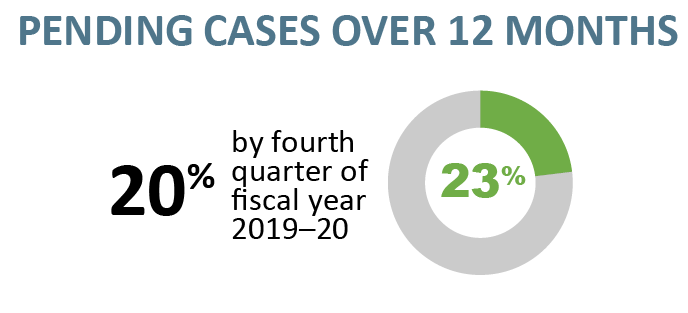
Text format
Pending Cases Over 12 Months
|
Pending over 12 months | 23% | 77% |
20% by the fourth quarter of the 2019-2020 fiscal year.

Text format
Pre-April 2018 Pending Cases
|
Pending over 12 months | 11% | 89% |
0% by further quarter of fiscal year 2019-2020
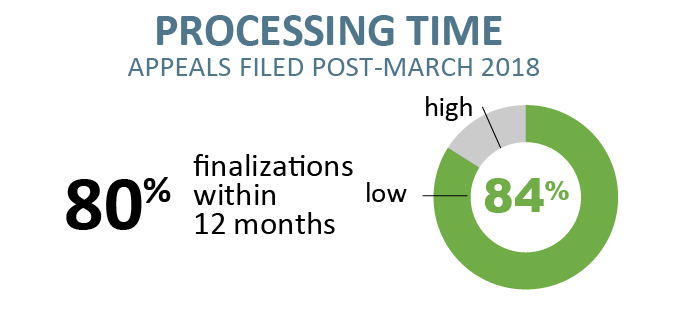
Text format
Processing Time
Appeals filed post-March 2018
|
Compliance Time Standard | 84% | 16% |
|
Low | 79% | - |
|
High | 91% | - |
80% finalizations within 12 months
ID Operational Plan Overview


Text format
Admissibility hearings
| 2019-20 Monthly Targets | APR | MAY | JUNE | JULY | AUG | SEPT | OCT | NOV | DEC | JAN | FEB | MAR | TOTAL |
|---|
|
Admissibility Hearings (AH) Funded Capacity (1.7k) | 142 | 142 | 142 | 141 | 141 | 142 | 142 | 142 | 141 | 142 | 141 | 142 | 1,700 |
|
Intake | 121 | 150 | 141 | 157 | 146 | 108 | - | - | - | - | - | - | - |
|
Intake (YTD) | 121 | 271 | 412 | 569 | 715 | 823 | 823 | 823 | 823 | 823 | 823 | 823 | - |
|
Actual | 137 | 162 | 145 | 140 | 112 | 126 | - | - | - | - | - | - | - |
|
Combined Intake and Funded Capacity | 122 | 150 | 141 | 158 | 141 | 142 | 142 | 142 | 141 | 142 | 141 | 142 | - |
|
Actual (YTD) | 137 | 299 | 444 | 584 | 696 | 822 | - | - | - | - | - | - | - |
|
Target (YTD) | 142 | 284 | 426 | 567 | 708 | 850 | - | - | - | - | - | - | - |
|
Variance from Target (YTD) | -4% | 5% | 4% | 3% | -2% | -3% | - | - | - | - | - | - | - |
|
Progress Towards Annual Target | 8% | 18% | 26% | 34% | 41% | 48% | - | - | - | - | - | - | - |
|
Variance from Intake (YTD) | 13% | 10% | 8% | 3% | -3% | 0% | - | - | - | - | - | - | - |

Text format
Detention Reviews
| 2019-20 Monthly Targets | APR | MAY | JUNE | JULY | AUG | SEPT | OCT | NOV | DEC | JAN | FEB | MAR | TOTAL |
|---|
|
Departmental Target (11.5k) | 960 | 958 | 958 | 960 | 958 | 958 | 958 | 958 | 958 | 958 | 958 | 958 | 11,500 |
|
Intake | 1,094 | 1,021 | 978 | 1,067 | 1,030 | 952 | - | - | - | - | - | - | - |
|
Intake (YTD) | 1,094 | 2,115 | 3,093 | 4,160 | 5,190 | 6,142 | - | - | - | - | - | - | - |
|
Actual | 1,079 | 1,065 | 967 | 1,054 | 1,052 | 950 | - | - | - | - | - | - | - |
|
Combined Intake and Funded Capacity | 1,093 | 1,021 | 978 | 1065 | 1032 | 958 | 958 | 958 | 958 | 958 | 958 | 958 | - |
|
Actual (YTD) | 1,079 | 2,144 | 3,111 | 4,165 | 5,217 | 6,167 | - | - | - | - | - | - | - |
|
Target (YTD) | 960 | 1,918 | 2,876 | 3,836 | 4,794 | 5,752 | - | - | - | - | - | - | - |
|
Variance from Target (YTD) | 12% | 12% | 8% | 9% | 9% | 7% | - | - | - | - | - | - | - |
|
Progress Towards Annual Target | 9% | 19% | 27% | 36% | 45% | 54% | - | - | - | - | - | - | - |
|
Variance from Intake (YTD) | -1% | 1% | 1% | 0% | 1% | 0% | - | - | - | - | - | - | - |
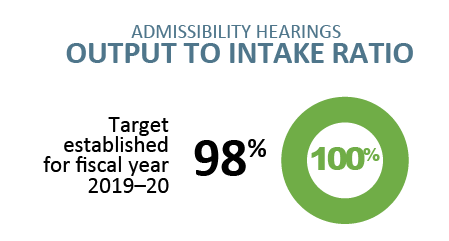
Text format
Admissibility hearings Output to intake ratio
Admissibility hearings Output to intake ratio
| 100% | 0% |
Target established for fiscal year 2019-2020 is 80%
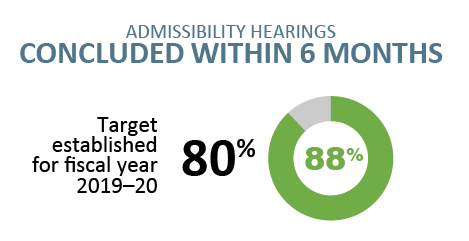
Text format
Admissibility hearings Concluded Within 6 Months
|
Admissibility hearings Concluded within 6 months | 88% | 12% |
Target established for fiscal year 2019-2020 is 80%
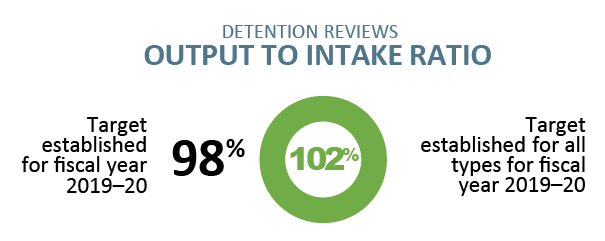
Text format
Detention reviews Output to intake ratio
|
Detention reviews output to intake ratio | 102% | 0% |
Target established for fiscal year 2019-2020 is 98%
Target established for all types for fiscal year 2019-2020 is 102%
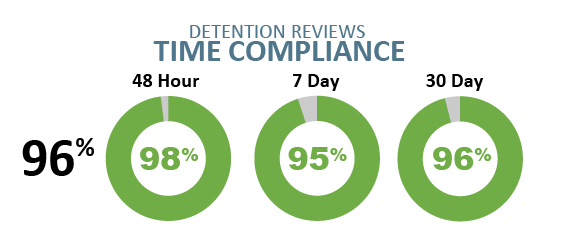
Text format
Detention reviews time compliance
| Detention reviews Time Compliance - 48 Hour | Detention reviews Time Compliance - 7 Day | Detention reviews Time Compliance - 30 Day |
|---|
| 98% | 95% | 96% |
| 2% | 5% | 4% |
Average - 96%
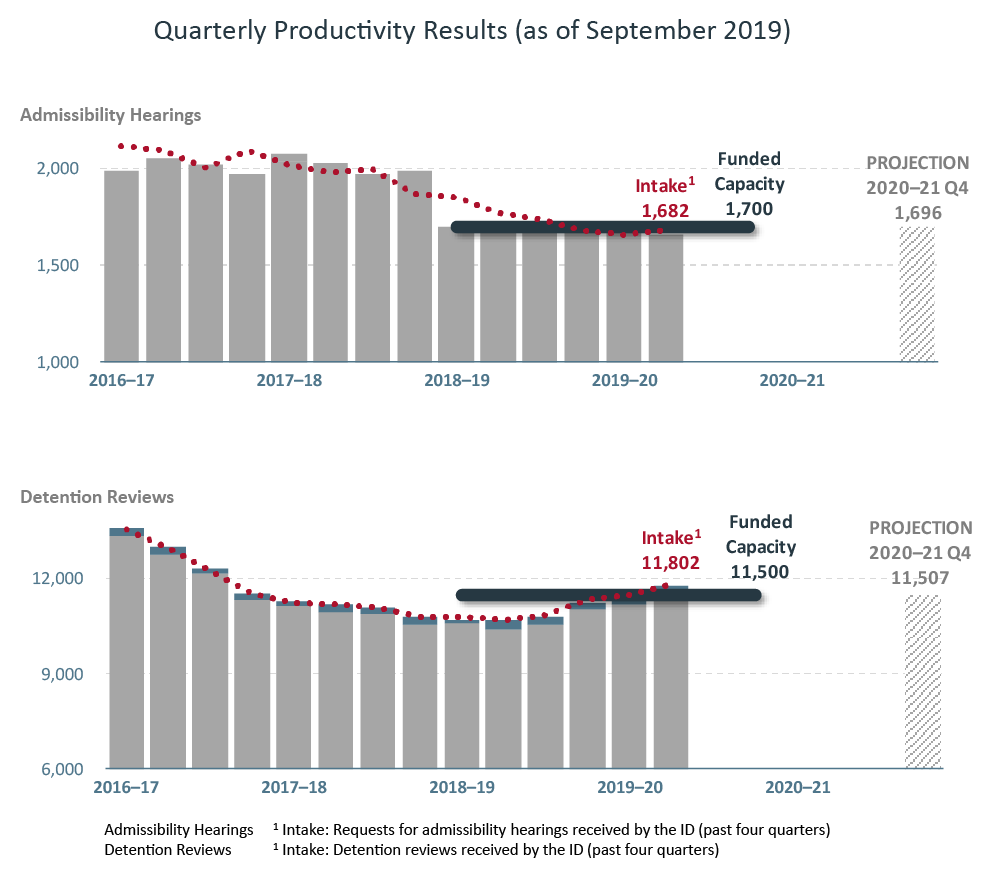
-
Text format
Quarterly Productivity Results (as of September 2019) - Admissibility Hearings
| | 2016–17 | 2017–18 | 2018–19 | 2019–20 | 2020–21 |
|---|
| - | - | Q1 | Q2 | Q3 | Q4 | Q1 | Q2 | Q3 | Q4 | Q1 | Q2 | Q3 | Q4 | Q1 | Q2 | Q3 | Q4 | Q1 | Q2 | Q3 | Q4 |
| Quarterly | Finalizations | 498 | 495 | 510 | 472 | 561 | 471 | 466 | 490 | 432 | 427 | 418 | 409 | 444 | 378 | - | - | - | - | - | - |
| Quarterly | Commitment | 500 | 500 | 500 | 500 | 500 | 500 | 500 | 500 | 475 | 475 | 475 | 475 | 425 | 425 | 425 | 425 | - | - | - | - |
| Quarterly | Difference vs Commitment | -2 | -5 | 10 | -28 | 61 | -29 | -34 | -10 | -43 | -48 | -57 | -66 | 19 | -47 | -425 | -425 | - | - | - | - |
| Quarterly | Finalizations above Commitment | 0 | 0 | 10 | 0 | 61 | 0 | 0 | 0 | 0 | 0 | 0 | 0 | 19 | 0 | 0 | 0 | - | - | - | - |
| 4Q Rolling | Finalizations | 1,986 | 2,055 | 2,022 | 1,975 | 2,038 | 2,014 | 1,970 | 1,988 | 1,859 | 1,815 | 1,767 | 1,686 | 1,698 | 1,649 | - | - | - | - | - | - |
| 4Q Rolling | Commitment | - | - | - | - | - | - | - | - | 1,700 | 1,700 | 1,700 | 1,700 | 1,700 | 1,700 | 1,700 | 1,700 | - | - | - | - |
| 4Q Rolling | Intake | 2,117 | 2,097 | 2,002 | 2,098 | 2,021 | 1,979 | 2,001 | 1,866 | 1,850 | 1,771 | 1,743 | 1,686 | 1,661 | 1,682 | - | - | - | - | - | - |
| 4Q Rolling | Finalizations up to Commitment | 1,986 | 2,055 | 2,022 | 1,975 | 2,038 | 2,014 | 1,970 | 1,988 | 1,700 | 1,700 | 1,700 | 1,686 | 1,698 | 1,649 | - | - | - | - | - | - |
| Previous 3Q | Finalizations | 1,488 | 1,560 | 1,512 | 1,503 | 1,477 | 1,543 | 1,504 | 1,498 | 1,268 | 1,273 | 1,282 | 1,277 | 1,254 | 1,271 | 0 | 0 | - | - | - | 1,696 |
| 4Q Rolling | Finalizations above Commitment | 0 | 0 | 0 | 0 | 38 | 14 | 0 | 0 | 0 | 0 | 0 | 0 | 1 | 2 | - | - | - | - | - | - |
| Cumulative | Finalizations above Commitment | -2 | -7 | 3 | -25 | 36 | 7 | -27 | -37 | -80 | -128 | -185 | -251 | -232 | -279 | - | - | - | - | - | - |
| Cumulative | Finalizations above Commitment since Q3 2017-18 | - | - | - | - | - | - | -34 | -44 | -87 | -135 | -192 | -258 | -239 | -286 | - | - | - | - | - | - |
| Pending | 406 | 422 | 357 | 496 | 388 | 387 | 387 | 374 | 379 | 342 | 365 | 374 | 342 | 375 | - | - | - | - | - | - |
-
Text format
Quarterly Productivity Results (as of September 2019) - Detention Reviews
| - | - | 2016–17 | 2017–18 | 2018–19 | 2019–20 | 2020–21 |
|---|
| - | - | Q1 | Q2 | Q3 | Q4 | Q1 | Q2 | Q3 | Q4 | Q1 | Q2 | Q3 | Q4 | Q1 | Q2 | Q3 | Q4 | Q1 | Q2 | Q3 | Q4 |
| Quarterly | Finalizations | 3,221 | 2,889 | 2,810 | 2,632 | 2,945 | 2,804 | 2,715 | 2,326 | 2,847 | 2,815 | 2,787 | 2,800 | 3,111 | 3,056 | - | - | - | - | - | - |
| Quarterly | Commitment | 3,500 | 3,500 | 3,500 | 3,500 | 2,875 | 2,875 | 2,875 | 2,875 | 2,875 | 2,875 | 2,875 | 2,875 | 2,875 | 2,875 | 2,875 | 2,875 | - | - | - | - |
| Quarterly | Difference vs Commitment | -279 | -611 | -690 | -868 | 70 | -71 | -160 | -549 | -28 | -60 | -88 | -75 | 236 | 181 | -2,875 | -2,875 | - | - | - | - |
| Quarterly | Finalizations above Commitment | 0 | 0 | 0 | 0 | 70 | 0 | 0 | 0 | 0 | 0 | 0 | 0 | 236 | 181 | 0 | 0 | - | - | - | - |
| 4Q Rolling | Finalizations | 13,600 | 13,007 | 12,309 | 11,552 | 11,276 | 11,191 | 11,096 | 10,790 | 10,692 | 10,703 | 10,775 | 11,249 | 11,513 | 11,754 | - | - | - | - | - | - |
| 4Q Rolling | Commitment | - | - | - | - | - | - | - | - | 11,500 | 11,500 | 11,500 | 11,500 | 11,500 | 11,500 | 11,500 | 11,500 | - | - | - | - |
| 4Q Rolling | Intake | 13,542 | 12,976 | 12,249 | 11,510 | 11,242 | 11,212 | 11,107 | 10,812 | 10,787 | 10,696 | 10,849 | 11,312 | 11,507 | 11,802 | - | - | - | - | - | - |
| 4Q Rolling | Finalizations up to Commitment | 13,600 | 13,007 | 12,309 | 11,552 | 11,276 | 11,191 | 11,096 | 10,790 | 10,692 | 10,703 | 10,775 | 11,249 | 11,500 | 11,500 | - | - | - | - | - | - |
| Previous 3Q | Finalizations | 10,379 | 10,118 | 9,499 | 8,920 | 8,331 | 8,387 | 8,381 | 8,464 | 7,845 | 7,888 | 7,988 | 8,449 | 8,389 | 8,444 | 0 | 0 | - | - | - | - |
| 4Q Rolling | Finalizations above Commitment | 0 | 0 | 0 | 0 | 0 | 0 | 0 | 0 | 0 | 0 | 0 | 0 | 1 | 2 | - | - | - | - | - | - |
| Cumulative | Finalizations above Commitment | -279 | -890 | -1,580 | -2,448 | -2,378 | -2,449 | -2,609 | -3,158 | -3,186 | -3,246 | -3,334 | -3,409 | -3,173 | -2,992 | - | - | - | - | - | - |
| Cumulative | Finalizations above Commitment since Q3 2017-18 | - | - | - | - | - | - | -160 | -709 | -737 | -797 | -885 | -960 | -724 | -543 | - | - | - | - | - | - |
| Pending | 406 | 392 | 350 | 384 | 345 | 383 | 358 | 396 | 451 | 384 | 358 | 392 | 375 | 367 | - | - | - | - | - | - |
| Time Compliance % | 98% | 98% | 99% | 98% | 99% | 98% | 98% | 98% | 99% | 97% | 98% | 98% | 97% | 98% | - | - | - | - | - | - |
| Time Compliance Value | 13,328 | 12,747 | 12,186 | 11,321 | 11,163 | 10,967 | 10,874 | 10,574 | 10,585 | 10,382 | 10,560 | 11,024 | 11,168 | 11,519 | - | - | - | - | - | 11,507 |
| Not Time Compliance Value | 272 | 260 | 123 | 231 | 113 | 224 | 222 | 216 | 107 | 321 | 216 | 225 | 345 | 235 | - | - | - | - | - | - |

Text format
ID Planned Annual Spending and Human Resources
| - | 2016-17 | 2017-18 | 2018-19 | 2019-20 | 2020-21 | 2021-22 |
|---|
|
FTEs Member | 33 | 33 | 33 | 33 | 33 | 33 |
|
FTEs Non-Member | 57 | 57 | 59 | 59 | 59 | 59 |
|
FTE Total | 90 | 90 | 92 | 92 | 92 | 92 |
|
Budget | 11,100,604 | 11,780,226 | 12,237,313 | 12,209,558 | 12,166,949 | 11,928,492 |
RAD Operational Plan Overview


Text format
RAD Operational Plan Overview
| 2019-20 Monthly Targets | APR | MAY | JUNE | JULY | AUG | SEPT | OCT | NOV | DEC | JAN | FEB | MAR | TOTAL |
|---|
|
Funded Performance Target (10,950) | 700 | 700 | 700 | 850 | 850 | 850 | 975 | 975 | 975 | 1,125 | 1,125 | 1,125 | 10,950 |
|
Revised (Aug.19) Trajectory to 10,950 (RAD) | 517 | 524 | 537 | 671 | 692 | 735 | 1,075 | 1,129 | 1,159 | 1,272 | 1,310 | 1,329 | 10,950 |
|
Merged Original and Funded | 700 | 700 | 700 | 850 | 850 | 850 | 1,075 | 1,129 | 1,159 | 1,272 | 1,310 | 1,388 | 11,983 |
|
Inverse of merged line | 517 | 524 | 537 | 671 | 692 | 735 | 975 | 975 | 975 | 1,125 | 1,125 | 1,125 | 9,976 |
|
Actual | 522 | 683 | 529 | 592 | 568 | 648 | - | - | - | - | - | - | - |
|
Actual (YTD) | 522 | 1160 | 1689 | 2281 | 2849 | 3497 | - | - | - | - | - | - | - |
|
Target (YTD) | 700 | 1,400 | 2,100 | 2,950 | 2,941 | 3,676 | 4,751 | 5,880 | 7,039 | 8,311 | 9,621 | 10,950 | - |
|
Variance from Target (YTD) | -25% | -17% | -20% | -23% | -3% | -5% | - | - | - | - | - | - | - |
|
Progress Towards Annual Target | 4% | 10% | 14% | 19% | 24% | 29% | - | - | - | - | - | - | - |
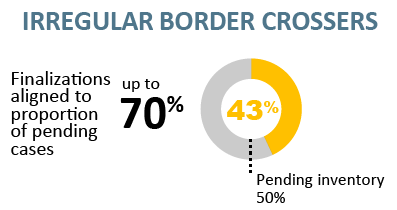
Text format
Irregular Border Crossers
|
Irregular Finalizations | 43% | 57% |
Finalizations aligned to proportions of pending cases up to 70%
Pending inventory: 50%

Text format
Processing time
|
Average processing time maintained within 1 year | 10 months |
Finalizations within 12 months
|
Finalizations within 12 months | 19% | 81% |
50% of decisions within 90 days of being perfected by 2019-2020 (four quarter).
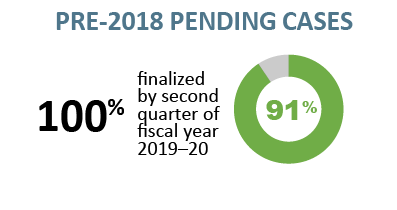
Text format
Pre-2018 Pending Cases
|
Pre-2018 Pending Cases | 91% | 9% |
100% finalized by second quarter of fiscal year 2019-2020

Text format
2018 Pending Cases
|
Pre-2019 Pending Cases | 47% | 53% |
75% finalized by fourth quarter of fiscal year 2019-2020
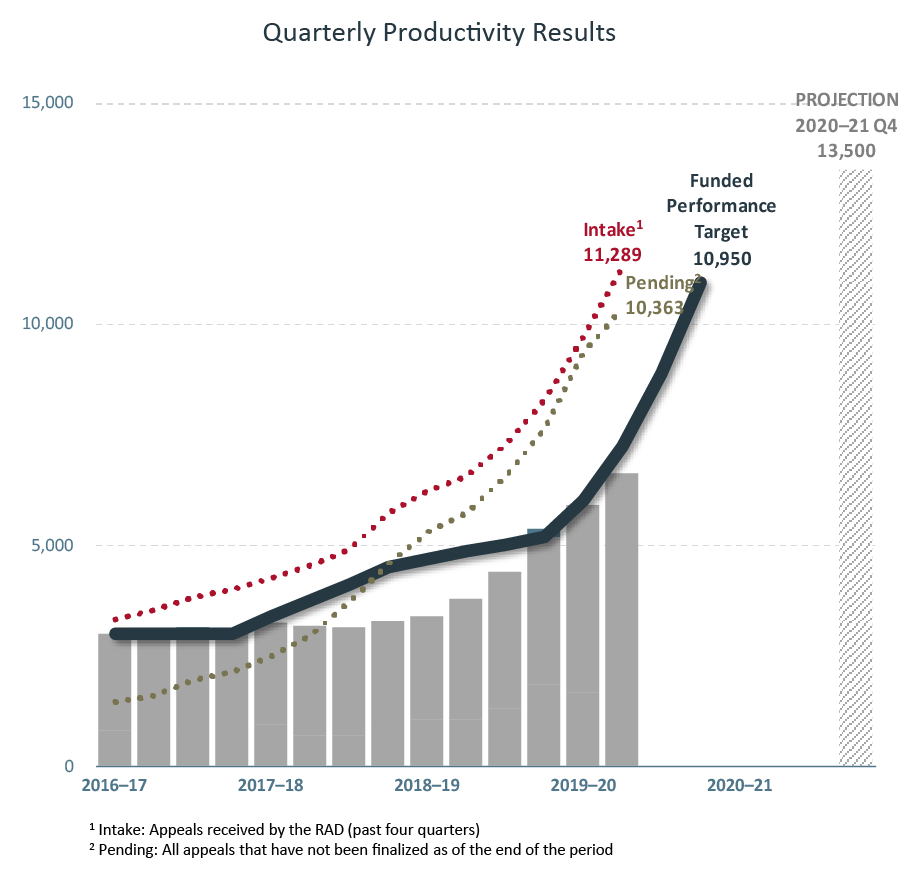
Text format
Refugee Appeals Division - quarterly productivity results
| | 2016–17 | 2017–18 | 2018–19 | 2019–20 | 2020–21 |
|---|
| - | - | Q1 | Q2 | Q3 | Q4 | Q1 | Q2 | Q3 | Q4 | Q1 | Q2 | Q3 | Q4 | Q1 | Q2 | Q3 | Q4 | Q1 | Q2 | Q3 | Q4 |
| Quarterly | Pending | 1,454 | 1,593 | 1,944 | 2,132 | 2,489 | 2,957 | 3,721 | 4,595 | 5,309 | 5,724 | 6,566 | 7,627 | 9,360 | 10,363 | - | - | - | - | - | - |
| Quarterly | Finalizations | 790 | 739 | 733 | 825 | 936 | 694 | 682 | 967 | 1,064 | 1,072 | 1,310 | 1,833 | ,682 | 1,808 | - | - | - | - | - | - |
| Quarterly | Commitment | 750 | 750 | 750 | 750 | 1,125 | 1,125 | 1,125 | 1,125 | 1,300 | 1,300 | 1,300 | 1,300 | 2,100 | 2,550 | 2,925 | 3,375 | -
| - | - | - |
| Quarterly | Difference vs Commitment | 40 | -11 | -17 | 75 | -189 | -431 | -443 | -158 | -236 | -228 | 10 | 533 | -418 | -742 | -2,925 | -3,375 | - | - | - | - |
| Quarterly | Finalizations above Commitment | 40 | 0 | 0 | 75 | 0 | 0 | 0 | 0 | 0 | 0 | 10 | 533 | 0 | 0 | 0 | 0 | - | - | - | - |
| 4Q Rolling | Finalizations | 3,000 | 2,968 | 3,137 | 3,087 | 3,233 | 3,188 | 3,137 | 3,279 | 3,407 | 3,785 | 4,413 | 5,279 | 5,897 | 6,633 | - | - | - | - | - | - |
| 4Q Rolling | Commitment | 3,000 | 3,000 | 3,000 | 3,000 | 3,375 | 3,750 | 4,125 | 4,500 | 4,675 | 4,850 | 5,025 | 5,200 | 6,000 | 7,250 | 8,875 | 10,950 | - | - | - | - |
| 4Q Rolling | Intake | 3,330 | 3,520 | 3,820 | 4,007 | 4,267 | 4,550 | 4,912 | 5,742 | 6,226 | 6,555 | 7,262 | 8,263 | 9,732 | 11,289 | - | - | - | - | - | - |
| 4Q Rolling | Finalizations up to Commitment | 3,000 | 2,968 | 3,000 | 3,000 | 3,233 | 3,188 | 3,137 | 3,279 | 3,407 | 3,785 | 4,413 | 5,200 | 5,897 | 6,633 | - | - | - | - | - | - |
| Previous 3Q | Finalizations | 2,210 | 2,229 | 2,267 | 2,175 | 2,297 | 2,494 | 2,455 | 2,312 | 2,343 | 2,713 | 3,103 | 3,367 | 4,215 | 4,825 | - | - | - | - | - | 13,500 |
| 4Q Rolling | Finalizations above Commitment | 0 | 0 | 137 | 87 | 0 | 0 | 0 | 0 | 0 | 0 | 0 | 179 | 0 | 0 | - | - | - | - | - | - |
| Cumulative | Finalizations above Commitment | 40 | 29 | 12 | 87 | -102 | -533 | -976 | -1,134 | -1,370 | -1,598 | -1,588 | -1,055 | -1,473 | -2,215 | - | - | - | - | - | - |
| Cumulative | Finalizations above Commitment since Q3 2017-18 | - | - | - | - | - | - | -443 | -601 | -837 | -1,065 | -1,055 | -522 | -940 | -1,682 | - | - | - | - | - | - |
Intake: (11,289) appeals received by the RAD (past four quarters)
Pending (10,363): all appeals that have not been finalized as of the end of the period
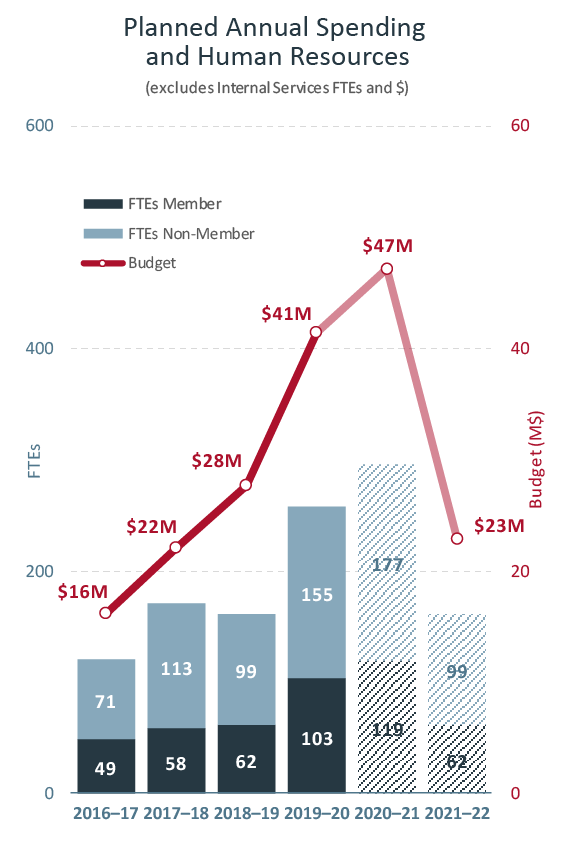
Text format
RAD - Planned Annual Spending and Human Resources
(excludes internal services FTEs and $)
| 2016-17 | 2017-18 | 2018-19 | 2019-20 | 2020-21 | 2021-22 |
|---|
|
FTEs Member | 46 | 58 | 62 | 103 | 119 | 62 |
|
FTEs Non-Member | 71 | 113 | 99 | 155 | 177 | 99 |
|
FTE Total | 120 | 171 | 161 | 258 | 296 | 161 |
|
Budget | 16,219,236 | 21,991,696 | 27,707,302 | 41,429,893 | 47,179,619 | 22,958,104 |
RPD Operational Plan Overview


Text format
RPD Operational Plan Overview
| 2019-20 Monthly Targets | APR | MAY | JUNE | JULY | AUG | SEPT | OCT | NOV | DEC | JAN | FEB | MAR | TOTAL |
|---|
|
High (48k) | 3,733 | 3,733 | 3,734 | 3,133 | 3,133 | 3,283 | 3,946 | 4,171 | 4,025 | 5,038 | 5,038 | 5,038 | 48,005 |
|
Mid (45k) | 3,733 | 3,733 | 3,734 | 3,133 | 3,133 | 3,283 | 3,751 | 3,751 | 3,601 | 4,383 | 4,383 | 4,383 | 45,001 |
|
Funded Performance Target (40,7k) | 3,733 | 3,733 | 3,733 | 2,833 | 2,833 | 2,833 | 3,301 | 3,301 | 3,301 | 3,701 | 3,701 | 3,701 | 40,704 |
|
Actual | 3,930 | 4,369 | 3,960 | 3,814 | 3,018 | 2,877 | - | - | - | - | - | - | - |
|
Actual (YTD) | 3,930 | 8,299 | 12,259 | 16,073 | 19,091 | 21,968 | - | - | - | - | - | - | - |
|
Target (YTD) | 3,733 | 7,466 | 11,199 | 14,032 | 16,865 | 19,698 | 22,999 | 26,300 | 29,601 | 33,302 | 37,003 | 40,704 | - |
|
Variance from Target (YTD) | 5% | 11% | 9% | 15% | 13% | 12% | - | - | - | - | - | - | - |
|
Progress Towards Annual Target | 10% | 20% | 30% | 39% | 47% | 54% | - | - | - | - | - | - | - |
|
Expected Progress Towards Target | 9% | 18% | 28% | 34% | 41% | 48% | - | - | - | - | - | - | - |
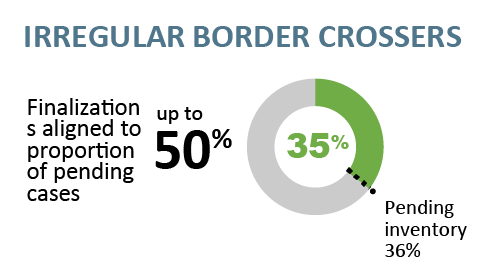
Text format
Irregular Border Crossers
|
Irregular Finalizations | 35% | 65% |
Finalizations aligned to proportion of pending cases, up to 50%
Pending inventory is 36%

Text format
Average processing time maiontained within 2 years
|
Average processing time maintained within 2 years | 15 months |
50% of decisions within 1 year of being referred by 2019-2020
|
Finalizations within 12 months | 36% | 64% |
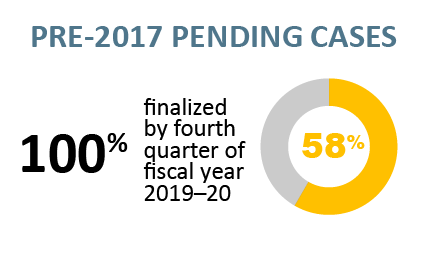
Text format
|
Pre-2017 pending cases | 58% | 42% |
100% finalized by fourth quarter of fiscal year, 2019-2020

Text format
2017 pending cases
|
2017 pending cases | 40% | 60% |
75% finalized by fourth quarter of fiscal year, 2019-2020
Inventory Overview – Divisional Statistics
RPD Inventory Analysis
Overall
Regular Claims
| 12-month period ending
| |
|---|
| Dec 31, 2015 | Dec 31, 2016 | Dec 31, 2017 | Dec 31, 2018 | Jan 1 – Sept 30, 2019 |
|---|
|
Received | 16,895 | 23,646 | 47,856 | 55,747 | 43,146 |
|
Finalized | 16,390 | 16,544 | 23,442 | 31,001 | 34,006 |
|
Pending | 16,833 | 23,942 | 48,356 | 73,102 | 82,243 |
Irregular Claims
| 12-month period ending | |
|---|
| Dec 31, 2017 | Dec 31, 2018 | Jan 1 – Sept 30, 2019 |
|---|
|
Received | 18,060 | 20,604 | 11,964 |
|
Finalized | 2,206 | 7,136 | 12,308 |
|
Pending | 15,854 | 29,322 | 29,978
|
- Between January 1, 2019 to September 30, 2019, intake was 43,146 cases, which is 7% more than the record volume received for the same period in 2018. Over that period, irregular intake declined 29% while regular intake increased 32%.
- The RPD finalized 42,224 cases in the 12-month period ending September 2019 – a record for any 12-month period since the asylum system was reformed in 2012 and a 42% increase over the 12-month period ending in September 2018.
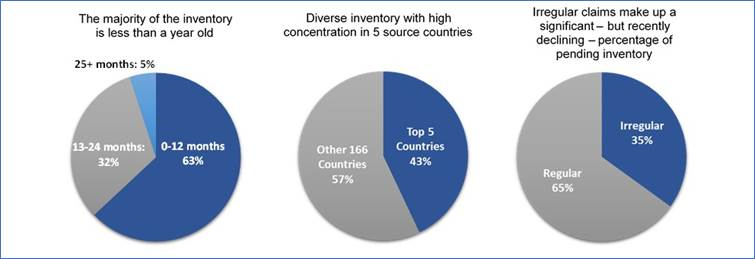
Text format
| The majority of the inventory is less than a year old |
|---|
| 0-12 months | 63% |
| 13-24 months | 32% |
| 25+ months | 5% |
| Diverse inventory with high concentration in 5 source countries |
|---|
| Top 5 Countires | 43% |
| Other 166 Countries | 57% |
| Irregular claims make up a significant - but recently declining - percentage of pending inventory |
|---|
| Regular | 65% |
| Irregular | 35% |
Pending Inventory
- Growth: As of end of September 2019, the pending inventory was 82,200, growing by over 1,000 claims per month on average since the beginning of the calendar year, down from over 2,000 claims per month in 2018.
- Age: 95% of pending claims are less than 2 years old (received from September 2017 to September 2019).
- 49% was received in 2019
- 40% was received in 2018
- 10% of the inventory was received in 2017
- Region: 49% of the inventory is in Eastern (Montreal) region, 43% is in Central (Toronto) region, and 8% is in Western (Vancouver) region.
-
Country Make-up:
| All Claims Source Country | Total Claims Pending | % of Inventory |
|---|
|
Top 10 Countries |
48,988 |
60% |
| Nigeria | 11,044 | 13% |
| India | 9,158 | 11% |
| Mexico | 5,813 | 7% |
| Haiti | 4,600 | 6% |
| Colombia | 4,366 | 5% |
| Iran | 4,296 | 5% |
| Pakistan | 3,000 | 4% |
| China | 2,925 | 4% |
| Congo, Democratic Republic | 2,172 | 3% |
| Turkey | 1,614 | 2% |
|
Other 161 Countries |
33,255 |
40% |
Top 10 Regular Claims
| Regular Claims Source Country | Regular Claims Pending | % of Regular Inventory |
|---|
|
Top 10 Countries |
31,414 |
59% |
| India | 9,048 | 17% |
| Mexico | 5,762 | 11% |
| Iran | 4,292 | 8% |
| China | 2,804 | 5% |
| Colombia | 2,333 | 4% |
| Nigeria | 1,908 | 4% |
| Pakistan | 1,896 | 4% |
| Turkey | 1,182 | 2% |
| Haiti | 1,132 | 2% |
| Venezuela | 1,057 | 2% |
|
157 Other Countries |
21,851 |
41% |
Top 10 Irregular Claims*
| Irregular Claims Source Country | Irregular Claims Pending | % of Irregular Inventory |
|---|
|
Top 10 Countries |
30,373 |
70% |
| Nigeria | 9,136 | 32% |
| Haiti | 3,468 | 12% |
| Colombia | 2,033 | 7% |
| Congo, Democratic Republic | 1,464 | 5% |
| Pakistan | 1,104 | 4% |
| Angola | 996 | 3% |
| Sudan | 701 | 2% |
| United States of America | 564 | 2% |
| Chad | 465 | 2% |
| Palestine | 442 | 2% |
|
Other 116 Countries |
8,605 |
30% |
*35% of claims in the inventory are from irregular arrivals, down from a peak of 43% in July 2018.
Wait Times
- Average wait times are estimated at 21 months as of the end of September 2019.
RAD Inventory Analysis
Overall
Regular Appeals
| 12-month period ending | |
|---|
| Dec 31, 2015 | Dec 31, 2016 | Dec 31, 2017 | Dec 31, 2018 | Jan 1 – Sept 30, 2019 |
|---|
|
Received | 2,959 | 3,821 | 4,912 | 7,263 | 9,136 |
|
Finalized | 2,781 | 2,968 | 3,136 | 4,417 | 5,339 |
|
Pending | 1,092 | 1,938 | 3,721 | 6,565 | 10,363 |
Irregular Appeals
| 12-month period ending | |
|---|
| Dec 31, 2017 | Dec 31, 2018 | Jan 1 – Sept 30, 2019 |
|---|
|
Received | 468 | 2,611 | 5,006 |
|
Finalized | 31 | 870 | 2,047 |
|
Pending | 437 | 2,178 | 5,140 |
- Between January 1, 2019 to September 30, 2019, intake was 9,136 appeals, which is 79% more than the record volume received for the same period in 2018. Over that period, irregular intake more than doubled while regular intake increased 16%. Intake has remained stable at approximately 27% of Refugee Protection Division finalizations.
- The RAD finalized 6,600 appeals in the 12-month period ending in September 2019 – a record 12-month total and a 75% increase over the 12-month period ending in September 2018.

Text format
| The majority of the inventory is less than a year old |
|---|
| 0-90 days | 26% |
| 3-12 months | 60% |
| 12+ months | 14% |
| Diverse inventory with high concentration in 5 source countries |
|---|
| Top 5 Countires | 61% |
| Other 132 Countries | 39% |
| Irregular appeals make up half the pending inventory |
|---|
| Regular | 50% |
| Irregular | 50% |
Pending Inventory
-
Growth: As of end of September 2019, the pending inventory was 10,400, growing by over 300 appeals per month on average since the beginning of the calendar year, up from over 200 appeals per month in 2018.
-
Age: 87% of pending appeals are less than 1 year old (received between October 2018 and September 2019)
-
Region: 47% of the inventory is in Central (Toronto) region, 43% is in Eastern (Montreal) region, and 10% is in Western (Vancouver) region.
-
Country Make-up:
| All Claims Source Country | Total Claims Pending | % of Inventory |
|---|
|
Top 10 Countries |
7,472 |
72% |
| Nigeria | 3,169 | 31% |
| Haiti | 1,498 | 14% |
| Mexico | 687 | 7% |
| China | 535 | 5% |
| India | 409 | 4% |
| Pakistan | 370 | 4% |
| Colombia | 239 | 2% |
| Iran | 191 | 2% |
| Somalia | 188 | 2% |
| United States of America | 186 | 2% |
|
Other 161 Countries |
2,891 |
28% |
Top 10 Regular Appeals
| Regular Appeals Source Country | Regular Appeals Pending | % of Regular Inventory |
|---|
|
Top 10 Countries |
3,046 |
59% |
| Mexico | 682 | 13% |
| Nigeria | 513 | 10% |
| China | 480 | 9% |
| India | 390 | 8% |
| Pakistan | 236 | 5% |
| Iran | 192 | 4% |
| Haiti | 189 | 4% |
| Somalia | 138 | 3% |
| Colombia | 124 | 2% |
| Colombia | 102 | 2% |
|
Other 121 Countries |
2,128 |
41% |
Top 10 Irregular Appeals*
| Irregular Appeals Source Country | Irregular Appeals Pending | % of Irregular Inventory |
|---|
|
Top 10 Countries |
4,522 |
88% |
| Nigeria | 2,639 | 52% |
| Haiti | 1,290 | 25% |
| Pakistan | 136 | 3% |
| United States of America | 110 | 2% |
| Colombia | 109 | 2% |
| Congo, Democratic Republic | 52 | 1% |
| China | 49 | 1% |
| Angola | 46 | 1% |
| Ghana | 46 | 1% |
| Somalia | 45 | 1% |
|
Other 65 Countries |
592 |
12% |
*50% of appeals in the inventory are from irregular arrivals, having increased steadily from 15% in January 2018.
Wait Times
- Average wait times are estimated at 9 months as of September 2019.
ID / IAD Inventory Analysis
Immigration Division
Overall
Admissibility Hearings
| 12-month period ending |
|---|
| Dec 31, 2015 | Dec 31, 2016 | Dec 31, 2017 | Dec 31, 2018 | Sept 30, 2019 |
|---|
| Received | 2,007 | 2,002 | 2,001 | 1,743 | 1,242 |
| Finalized | 1,897 | 2,022 | 1,970 | 1,767 | 1,231 |
| Pending | 376 | 357 | 387 | 365 | 375 |
Detention Reviews
| 12-month period ending |
|---|
| Dec 31, 2015 | Dec 31, 2016 | Dec 31, 2017 | Dec 31, 2018 | Sept 30, 2019 |
|---|
| Received | 13,994 | 12,245 | 11,107 | 10,849 | 8,981 |
| Finalized | 14,047 | 12,309 | 11,096 | 10,775 | 8,967 |
| Pending | 408 | 328 | 336 | 358 | 367 |
Immigration Appeal Division
Overall
| 12-month period ending |
|---|
| Dec 31, 2015 | Dec 31, 2016 | Dec 31, 2017 | Dec 31, 2018 | Sept 30, 2019 |
|---|
| Received | 5,350 | 5,745 | 5,297 | 4,357 | 3,084 |
| Finalized | 6,340 | 6,366 | 6,586 | 7,198 | 4,782 |
| Pending | 10,798 | 10,177 | 8,888 | 6,047 | 4,350 |
Top Media Stories and Active Litigation
Given the nature of its mandate, the Immigration and Refugee Board of Canada (IRB) is the focus of considerable media attention. Much of this attention is focussed on the Immigration Division (ID), whose hearings are generally held in public and frequently involve individuals with backgrounds or profiles that are likely to attract public interest. In contrast, proceedings before the Refugee Protection Division (RPD) and Refugee Appeal Division (RAD) are generally held in private, and it is therefore uncommon for these cases to feature in the media, although there is recurring media interest in systemic issues related to the work of the RPD in particular, including for example issues related to capacity, backlog growth and wait times.
In addition, there are a number of cases currently before the Federal Court (FC) and Federal Court of Appeal (FCA) where the Court’s decision may impact on the IRB and its processes.
Below is a summary of select media stories and ongoing litigation, which has recently generated some public interest.
Media
Othman Ayed Hamdan
Mr. Hamdan is a Jordanian citizen who came to Canada in 2002. He was found to be a Convention Refugee in 2004. In October, 2018, the RPD allowed the Minister of Public Safety and Emergency Preparedness application to cease refugee protection, which had the effect of revoking Mr. Hamdan’s protected person status. Mr. Hamdan filed an application for leave and judicial review challenging that decision. The Federal Court denied leave.
He was arrested and charged with four counts relating to inciting terrorism in July 2015. Upon his acquittal on September 22, 2017, Mr. Hamdan was arrested and detained under the Immigration and Refugee Protection Act (IRPA) by the CBSA based on allegations that he was inadmissible under the IRPA for being a danger to the security of Canada. On October 18, 2018 the ID found him inadmissible on that ground and issued a deportation order. On February 1, 2019 the Federal Court denied leave for judicial review of the ID inadmissibility decision. Since September 2017, the Immigration Division (ID) had ordered his continued detention at mandatory detention review hearings on the ground that he is a danger to the public. In August 2019, the ID ordered Mr. Hamdan’s release with 26 terms and conditions. The Minister of Public Safety and Emergency Preparedness subsequently made an application for judicial review of the ID’s decision to release Mr. Hamdan. On September 3, 2019, the Federal Court dismissed the Minister’s application for judicial review thereby upholding the ID decision to release. Mr. Hamdan has been released from detention and currently resides in Enderby, British Columbia. No further IRB activity is expected unless Mr. Hamdan is detained again by the CBSA for breach of terms and conditions, is detained for removal, or applies for changes in terms and conditions.
Elena Crenna
Elena Crenna, a Russian-born U.S. citizen, is a dual citizen of the United States and Russia. In 2012, she married David Crenna, a Canadian citizen who, in December 2013, applied to sponsor her as a permanent resident. Mrs. Crenna is the subject of inadmissibility proceedings by the Government of Canada for engaging in espionage. Specifically, the Minister of Public Safety and Emergency Preparedness alleged that between 1994 and 1998 Mrs. Crenna spied on a Canadian sponsored housing project in the city of Tver, Russia. On May 31, 2018, the ID determined that the allegations were not well-founded since the Minister was not able to identify any clear risk to Canadian interests which was brought about by Russia’s federal security service’s interest in the Tver housing project. Therefore, no removal order was issued. In its ruling, the ID wrote that while Mrs. Crenna had provided information about a Canadian project to Russia’s FSB Federal Security Service, her conduct did not amount to espionage.
The Minister of Public Safety and Emergency Preparedness appealed the ID decision to the Immigration Appeal Division (IAD). On June 20, 2019 the IAD allowed the Minister’s appeal and a removal order was issued against Mrs. Crenna. On July 5, 2019, Mrs. Crenna filed an application for leave and judicial review against the IAD decision before the Federal Court.
Mrs. Crenna and her Canadian husband are appealing the deportation order and calling on the Federal Court to clarify the definition of espionage. As of November 13, 2019, the case remains pending before the Federal Court.
Man claiming to be former CSIS operative
This case involves a person whose refugee claim was originally referred to the Refugee Protection Division (RPD) in 2009. The claim was determined to be abandoned. A removal order was subsequently issued following which an application for leave and Judicial Review was filed with the Federal Court in December 2011. The application for leave was dismissed in May 2012.
This person appeared in the media for the first time in September 2019, when it was reported that he claimed he was a CSIS undercover counter-terrorism operative and that he feared death if he were deported. Subsequent media coverage reported that the man had doused himself with gasoline outside the Halifax office of the Canadian Security Intelligence Service, where he claimed he worked as an undercover operative. The person concerned claims to have saved many Canadians as an agent for the Canadian intelligence agency for four years while based in Halifax and believes he faces certain death if deported to Israel. The person concerned is currently detained by the CBSA in Nova Scotia since September 9, 2019. A 48-hour detention review was held on September 11, 2019, with detention maintained for reason of flight risk and danger to the public. The person concerned had a 7-day detention review on September 18, 2019, with the decision being continued detention. The person concerned remains in detention with the next hearing scheduled for November 14, 2019.
Litigation
Pending
Canadian Association of Refugee Lawyers et al. v. Canada (Immigration, Refugees and Citizenship) et al. (Federal Court)
This litigation challenges the Safe Third Country Agreement (STCA) regime. In particular, it challenges the constitutionality of the STCA and the ongoing designation of the United States as a safe third country under the
Immigration and Refugee Protection Act and the Regulations.
The outcome of this litigation could have a significant impact on the volume of claims before the Refugee Protection Division and appeals to the Refugee Appeal Division. The judicial review was heard by the Federal Court from November 4-8, 2019.
Revell v. MCI & Moretto v M.C.I. (Federal Court of Appeal)
This case involves a Charter challenge to the deportation of a long-term permanent resident convicted of a serious criminal offence. It considers whether section 7 of the Charter (liberty and security interests) is invoked at the stage of admissibility hearings before the Immigration Division.
The Federal Court of Appeal (FCA) released its decision (A-316-17) on October 18, 2019. In dismissing the appeal, the FCA determined that s. 7 of the Charter is not engaged before the ID when determining whether a permanent resident is inadmissible to Canada. Since other steps remain in the deportation process, a finding of inadmissibility does not automatically result in deportation and therefore does not engage section 7 of the Charter.
The FCA said it was bound by previous Supreme Court of Canada (SCC) decisions that determined that s. 7 of the Charter is not engaged at this stage in the deportation process. The FCA noted that the SCC has set a high threshold for a lower court to reconsider settled precedents from a higher court and the criteria to depart from binding precedent was not met in this case.
Alvin Brown et al v. MCI et al (Federal Court of Appeal)
At the heart of this appeal is a challenge to the constitutionality of the legislative provisions in the IRPA regarding detention. Counsel for Mr. Brown argued that in practice the detention scheme in the IRPA allows persons to be held in immigration detention indefinitely and argued the scheme is contrary to the Charter. Counsel for Mr. Brown also urged the Federal Court to rule that the Charter imposes a requirement that detention for immigration purposes not exceed a prescribed period of time, after which it is presumptively unconstitutional, or a maximum period, after which release is mandatory. A finding that the detention scheme in the IRPA is unconstitutional could ultimately lead to a re-writing of the detention provisions in the IRPA.
The case is pending before the Federal Court of Appeal.
Canadian Association of Refugee Lawyers v. Canada (Immigration, Refugees and Citizenship) (Federal Court of Appeal)
This case concerns the IRB Chairperson’s authority with respect to the issuance of Jurisprudential Guides. Jurisprudential Guides are used to promote consistency and efficiency in decision-making.
In its decision in September 2019, the Federal Court confirmed the Chairperson’s authority to identify IRB decisions as Jurisprudential Guides and upheld the Board’s existing process for identifying them. The decision also confirmed that the Board can issue Jurisprudential Guides on matters of law, fact, and mixed law and fact. However, the Court found that there was an impermissible interference with members’ independence due to policy statements that accompanied the Jurisprudential Guides which indicated that members are expected, rather than encouraged, to apply Jurisprudential Guides in cases with similar facts or provide reasoned justification for not doing so.
The IRB is in the process of reviewing all relevant policy instruments to ensure compliance with the Federal Court decision and to better align the Policy on the Use of Jurisprudential Guides with existing IRB practices. It is estimated that there are less than 50 pending cases before the Refugee Appeal Division where one of the affected Jurisprudential Guides was cited.
The Canadian Association of Refugee Lawyers filed an appeal of the Federal Court’s decision and the IRB has sought intervenor status with the Federal Court of Appeal on October 2, 2019. The Government cross-appealed in part on October 11, 2019.
Key Issues Requiring Ministerial Support
The following are key issues requiring early attention:
-
Timely appointment and reappointment of Governor in Council (GIC) decision-makers at the Refugee Appeal Division (RAD) and Immigration Appeal Division (IAD) – With the RAD and IAD staffed by GIC decision-makers, continued timely appointments and reappointments is critical in support of these Divisions maintaining expected levels of productivity. Between now and December 2019, the IRB will work with your office to advance 17 appointments and reappointments across both Divisions. Additional appointments will also be required in early 2020.
-
Longer term funding to meet intake and address accumulated backlogs – The IRB has received significant funding to increase its capacity to finalize refugee claims and refugee appeals. The IRB is fully on track to meet performance expectations. However, this funding is currently scheduled to end in fiscal year 2020-21. Early discussions regarding longer term funding that provides the IRB sufficient capacity to match claim intake and to begin to reduce the backlog will be required.
The IRB will work with central agencies, IRCC and your office to advance these priority issues.